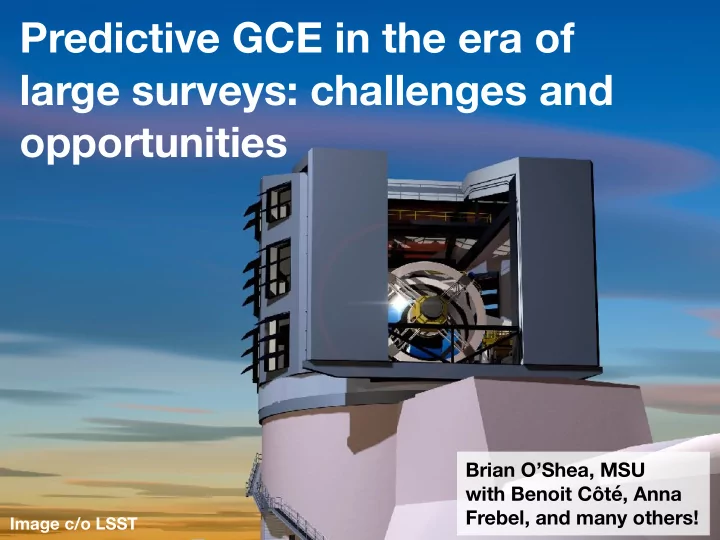

Predictive GCE in the era of large surveys: challenges and opportunities Brian O’Shea, MSU with Benoit Côté, Anna Frebel, and many others! Image c/o LSST
What ingredients are needed for GCE… • in the era of many and diverse large, accurate, and precise astronomical surveys? • that appropriately takes into account the impact of cosmological structure formation? • to pose questions where we can be confident in the robustness of our answers?
A simple GCE model Star formation rate Galactic outflow Galactic inflow M Z ( t ) = Y ˙ ˙ Metal production M ∗ ( t ) (see, e.g., Côté et al. 2016 and many others)
A deeper dive into the ingredients
Nuclear physics Uncertainties: reaction rates and cross sections Image c/o Michigan State University
Star formation Uncertainties: shape of IMF and its dependence on formation environment; stellar multiplicity; orbital properties Eagle Nebula (M16/NGC6611), image c/o ESO
Stellar evolution Uncertainties: mass range for Type II supernovae and remnants; Type Ia progenitor(s); compact object merger rates and properties Images c/o NASA
Galaxy properties M82 (image c/o NASA)
Uncertainties: the mass and formation history of the Milky Way and its satellites Movie c/o Brendan Griffen, MIT (Caterpillar Project: Griffen+ 2016, ApJ, 818:10; Griffen+ 2018, MNRAS, 2018, 474:443)
Uncertainties: the mass and formation history of the Milky Way and its satellites Movie c/o Brendan Griffen, MIT (Caterpillar Project: Griffen+ 2016, ApJ, 818:10; Griffen+ 2018, MNRAS, 2018, 474:443)
Uncertainties: the behavior of gas as it flows into and out of galaxies; mixing of metals into ISM, CGM, IGM ~150 kpc (0.3 R vir ) Movie: Corlies, Peeples, O’Shea, Tumlinson (2018)
A more realistic galaxy model Côté et al. 2018 (ApJ, 859:67)
Propagation of uncertainty Côté et al. 2016 (ApJ, 824:82)
Uncertainty in a one-zone MW model Lower bound of IMF Upper bound of IMF IMF slope Type Ia delay MW z=0 stellar Type Ia normalization time distn. mass Côté et al. 2016 (ApJ, 824:82)
Varying N Ia only
Varying ! only
Varying everything simultaneously!
Varying everything simultaneously!
Uncertainties in galaxy model parameterizations 3 Inflow/outflow models fit to Sculptor; Côté et al. 2017 (ApJ, 835:128)
Uncertainties in galaxy model parameterizations 3 Inflow/outflow models fit to Sculptor; Côté et al. 2017 (ApJ, 835:128)
Uncertainty in MW formation history Côté, O’Shea, Frebel, et al. 2018 (in prep.)
Uncertainty in MW formation history
How do we deal with these uncertainties? Use physics-rich galaxy formation simulations to calibrate models! Côté et al. 2018 (ApJ, 859:67)
Comparing to observations
Gaussian process emulators Gómez et al. 2012 (ApJ, 760:112)
Gómez et al. 2012 (ApJ, 760:112)
Parameter sensitivity analysis Gómez et al. 2014 (ApJ, 787:20)
Overall goal: robust, quantitative predictions* from models compared to observed chemical abundances in stars, using r-process enrichment at low metallicity as an example application! *with estimates of true uncertainty from models and observations
Where do things stand? • Existing theoretical tools : SYGMA, OMEGA+, GAMMA, Gaussian Process emulator, MCMC. • Existing observational databases : JINABase, Stellab • Theory needs : metal mixing model, disk model, dark matter particle tagging. • Observational needs : additional datasets! Expect entire pipeline by this time next year!
To summarize: 1. Making quantitative, believable predictions taking advantage of modern observational surveys requires a sophisticated GCE framework 2. Hydrodynamic simulations can inform GCE models in a variety of useful ways (and make prettier pictures) 3. The future of the JINA-CEE GCE pipeline is bright!
Recommend
More recommend